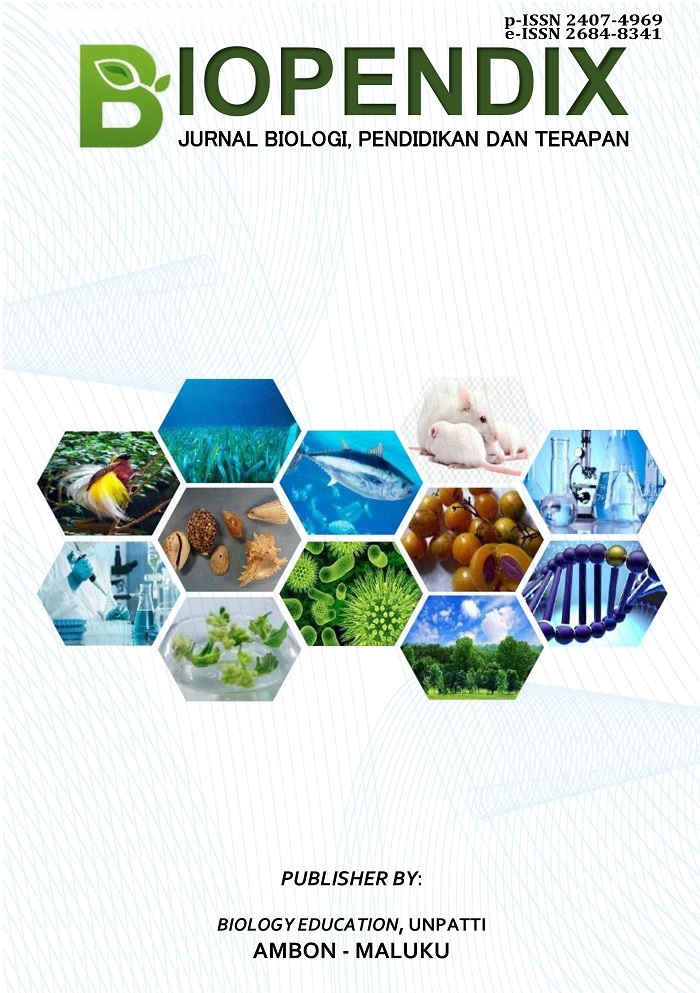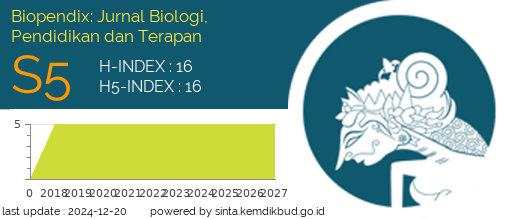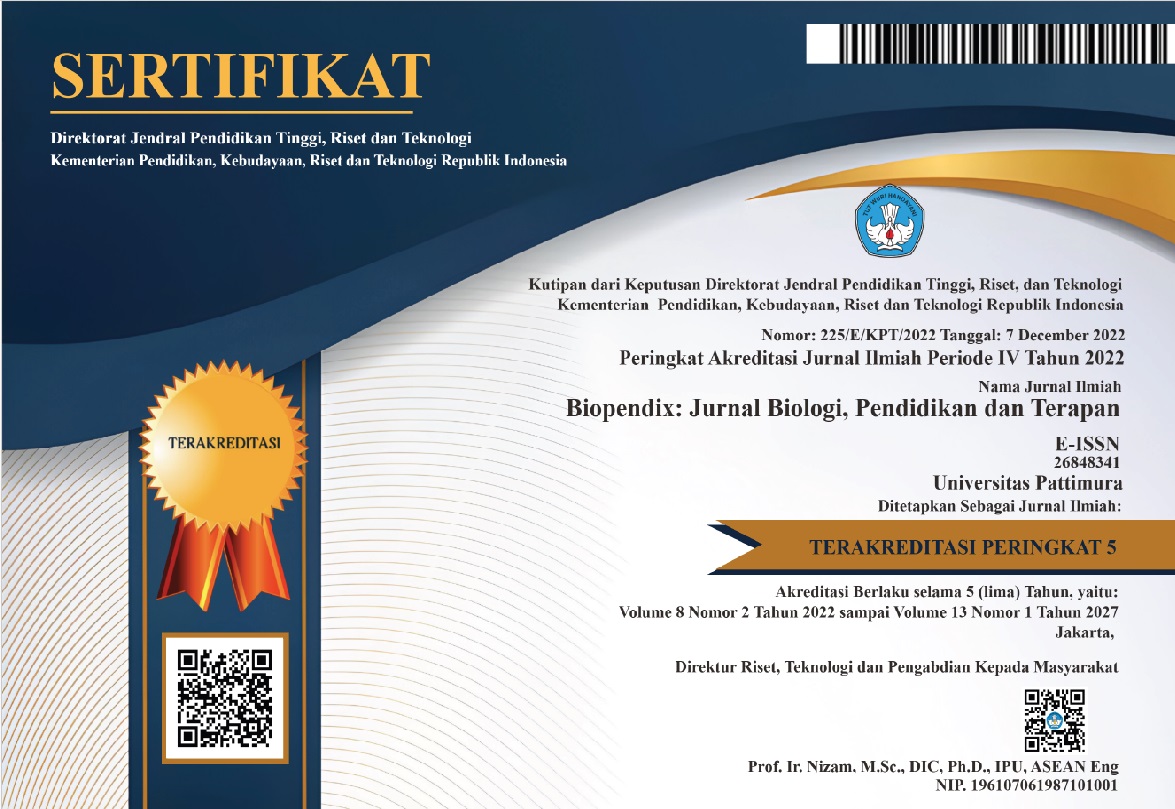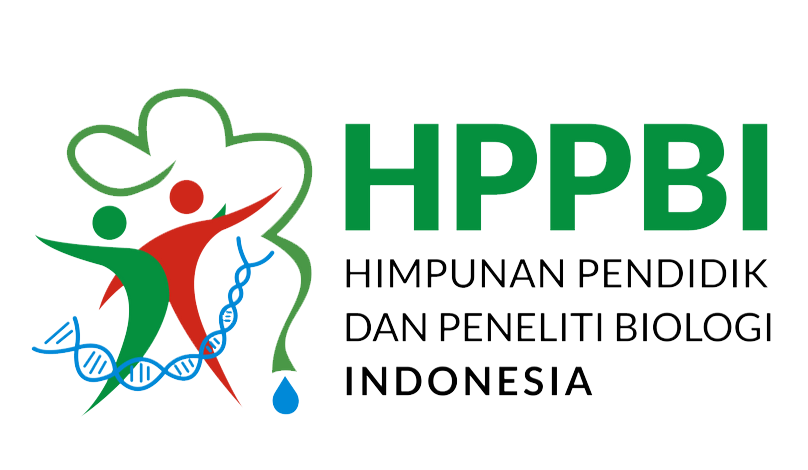The Role of COMT (Val158Met) Polymorphism in Variation of Children’s Cognition and Learning Character
Abstract
This study exakines the role of the COMT Val158Met genetic polymorphism in variations of children's cognition and learning character through a systematic literature review. This approach aims to understand how internal biological factors influence differences in children's learning styles and academic performance, as well as to highlight the importance of the interaction between genetic factors and the learning environment (gene x environment interaction). Through the search and analysis of relevant scientific articles from various international and national databases, this study found that genetic variations in COMT affect dopamine activity and neurotransmitter mechanisms, impacting executive function, emotion regulation, and responses to academic stress. The research findings conclude that understanding molecular genetics in the context of education can support the development of more personalized and adaptive learning approaches and support the implementation of neurodiversity-based educational strategies. This study also indicates the need for further research on the direct relationship between COMT polymorphism and learning characteristics in Indonesia, which is still limited at present.
Downloads
References
Ainayya, S., Kuala, U. S., Besar, K. A., Indonesia, P. B., & The, T. A. (2025). Implementasi Pembelajaran Berdiferensiasi Melalui Pendekatan Teaching At The Right Level ( TARL ) Dalam Pembelajaran Bahasa Indonesia Pada Kelas V SD. Esensi Pendidikan Inspiratif, 7(1), 389–406.
Amin, A., Yonani, S., Pendidikan, P., Islam, A., Islam, U., Famawati, N., Bengkulu, S., Artikel, I., Islam, P., Individual, P., & Education, J. (2024). Urgensi Inovasi Pendekatan Individual Dalam Meningkatkan Kualitas Belajar Perspektif Pendidikan Islam. Jurnal Education and Development, 12(3), 472–479. https://doi.org/10.37081/ed.v12i3.6351
Cahill, S., Chandola, T., & Hager, R. (2022). Genetic Variants Associated With Resilience in Human and Animal Studies. Frontiers in Psychiatry, 13(May), 1–29. https://doi.org/10.3389/fpsyt.2022.840120
Chen, C. Y., Tian, R., Ge, T., Lam, M., Sanchez-Andrade, G., Singh, T., Urpa, L., Liu, J. Z., Sanderson, M., Rowley, C., Ironfield, H., Fang, T., Kyttälä, A., Elliott, A., Kämpe, A., Sourander, A., Tuulio-Henriksson, A., Solismaa, A., Tanskanen, A., … Runz, H. (2023). The impact of rare protein coding genetic variation on adult cognitive function. Nature Genetics, 55(6), 927–938. https://doi.org/10.1038/s41588-023-01398-8
Dobewall, H., Saarinen, A., Lyytikäinen, L. P., Keltikangas-Järvinen, L., Lehtimäki, T., & Hintsanen, M. (2021). Functional Polymorphisms in Oxytocin and Dopamine Pathway Genes and the Development of Dispositional Compassion Over Time: The Young Finns Study. Frontiers in Psychology, 12(April), 1–12. https://doi.org/10.3389/fpsyg.2021.576346
Febyan, F., Wijaya, S. H., Tannika, A., & Hudyono, J. (2020). Peranan Sitokin pada Keadaan Stres sebagai Pencetus Depresi. Jurnal Penyakit Dalam Indonesia, 6(4), 210. https://doi.org/10.7454/jpdi.v6i4.285
Gerra, M. C., Dallabona, C., Manfredini, M., Giordano, R., Capriotti, C., González-Villar, A., Triñanes, Y., Arendt-Nielsen, L., & Carrillo-de-la-Peña, M. T. (2024). The polymorphism Val158Met in the COMT gene: disrupted dopamine system in fibromyalgia patients? Pain, 165, 184–189. https://doi.org/10.1097/j.pain.0000000000003313
Koyama, E., Kant, T., Takata, A., Kennedy, J. L., & Zai, C. C. (2024). Genetics of child aggression, a systematic review. Translational Psychiatry, 14(1). https://doi.org/10.1038/s41398-024-02870-7
Lee, L., & Prescott, C. (2014). Association of the Catechol-O-Methyltransferase (COMT) Val158Met Polymorphism and Anxiety-Related Traits: A Meta- Analysis. Psychiatr Genet, 24(2), 52–69. https://doi.org/10.1097/YPG.0000000000000018.
Roomaney, A. A., Womersley, J. S., Swart, P. C., Spies, G., Seedat, S., & Hemmings, S. M. J. (2022). Childhood trauma and genetic variation in the DAT 40-bp VNTR contribute to HIV-associated neurocognitive disorders. IBRO Neuroscience Reports, 12(December 2021), 45–54. https://doi.org/10.1016/j.ibneur.2021.12.003
Sultan, U., & Syafiuddin, M. (2025). Menggali Potensi Optimal Anak Usia Dini : Tinjauan Literatur. Jurnal Ilmiah Edukatif, 11, 68–78. https://doi.org/10.37567/jie.v11i1.3605
Turhusna, D., & Solatun, S. (2020). Perbedaan Individu dalam Proses Pembelajaran. As-Sabiqun, 2(1), 18–42. https://doi.org/10.36088/assabiqun.v2i1.613
Weidler, C., Hofhansel, L., Regenbogen, C., Müller, D., Clemens, B., Montag, C., Reif, A., & Habel, U. (2024). The influence of the COMT Val158Met polymorphism on prefrontal TDCS effects on aggression. Scientific Reports, 14(1), 1–10. https://doi.org/10.1038/s41598-024-53930-3
Xu, S., Wu, N., Liu, X., Zhu, J., & Liu, Z. (2024). The Catechol‐O‐Methyltransferase (COMT) Val158Met Polymorphism Is Associated with Oxycodone Requirements, Adverse Effects, and Pain Sensitivity in Cancer Patients. Journal of Clinical Pharmacy and Therapeutics, 2024(1), 9990112. https://doi.org/10.1155/2024/9990112
Zagoto, M. M., Yarni, N., & Dakhi, O. (2019). Perbedaan Individu Dari Gaya Belajarnya Serta Implikasinya Dalam Pembelajaran. Jurnal Review Pendidikan Dan Pengajaran, 2(2), 259–265. https://doi.org/10.31004/jrpp.v2i2.481
Copyright (c) 2025 Dhea Nicky, Dewi Mustikaningtyas

This work is licensed under a Creative Commons Attribution-ShareAlike 4.0 International License.
Authors who publish with this Journal agree to the following terms:
- Author retain copyright and grant the journal right of first publication with the work simultaneously licensed under a creative commons attribution license that allow others to share the work within an acknowledgement of the work’s authorship and initial publication of this journal.
- Authors are able to enter into separate, additional contractual arrangement for the non-exclusive distribution of the journal’s published version of the work (e.g. acknowledgement of its initial publication in this journal).
- Authors are permitted and encouraged to post their work online (e.g. in institutional repositories or on their websites) prior to and during the submission process, as it can lead to productive exchanges, as well as earlier and greater citation of published works





 2
2






